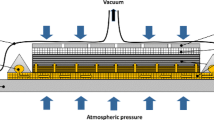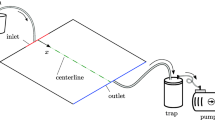Abstract
The modelling of composite manufacturing processes where hydro-mechanical coupling takes place depends on the validity of compressibility and permeability models. In this work, the computer code initially used to simulate the effect of coupled hydro-mechanical load on composite preform (Ouahbi et al. Composites Part A, 38:1646–1654, 2007) is integrated into an inverse method to predict the compaction behaviour of the reinforcements. An experimental device developed at Le Havre is used to apply hydro-mechanical loads to the preforms. Two ramps of stress are imposed to the preform and the thickness evolution is measured as a function of time. The speed of thickness reduction is not constant and varies in the range of 0.1 to 12 mm/min. The effect of compression speed upon the saturated fabrics is investigated. For a fixed fibre volume fraction, an increase in stress is observed in increasing compression speed. The experimental results are compared to the compressibility curves determined by an inverse method. The calculated curves correspond to the compressibility curves experimentally obtained with low compression speed (∼0.25 mm/min). As a consequence, this suggests that a low compression speed should be applied when investigating the compressibility behaviour of composite preform with a view of modelling resin infusion processes.









Similar content being viewed by others
References
Bréard J, Saouab A (2005) Numerical simulation of liquid composite molding processes. European Journal of Computational Mechanics 14:841–865
Antonucci V, Giordano M, Nicolais L, Calabro A, Cusano A, Cutolo A, Inserra S (2003) Resin flow monitoring in resin film infusion process. J Mater Process Technol 143–144:687–692
Correia NC, Robitaille F, Long AC, Rudd CD, Simacek P, Advani SG (2005) Analysis of the vacuum infusion moulding process: I. Analytical formulation. Compos Part A 36:1645–1656
Lopatnikov S, Simacek P, Gillespie J, Advani SG (2004) A closed form solution to describe infusion of resin under vacuum in deformable fibrous porous media. Model Simul Mater Sci Eng 12:191–204
Sommer JL, Mortensen A (1996) Forced unidirectional infiltration of deformable porous media. J Fluid Mech 22:1205–1222
Ouahbi T, Saouab A, Bréard J, Ouagne P, Chatel S (2007) Modeling of hydro-mechanical coupling in infusion processes. Compos Part A 38:1646–1654
Park J, Kang MK (2003) A numerical simulation of the resin film infusion process. Composite Structures 60:431–437
Darcy H (1856) Les fontaines publiques de la ville de Dijon. Dalmont, Paris
Robitaille F, Gauvin R (1998) Compaction of textile reinforcements for composites manufacturing. I: review of experimental results. Polym Compos 19:198–216
Bickerton S, Buntain MJ, Somashekar AA (2003) The viscoelastic compression behaviour of liquid composite molding performs. Compos Part A 34:431–444
Toll S, Manson JAE (1994) An analysis of the compressibility of fiber assemblies. In: Proceeding of the sixth International Conference on Fiber-Reinforced Composites, Institute of Materials, Newcastle upon Tyne, UK, 1994, pp 25/1–25/10
Mehri D, Michaud V, Comte E, Manson JAE (2006) Predicting the sizing dependent rigidity of glass fibre bundles in sheet moulding compounds. Compos Part A 37:1773–1786
Luo Y, Verpoest I (1999) Compressibility and relaxation of a new sandwich textile preform for liquid composite molding. Polym Compos 20:179–191
Kelly PA, Umer R, Bickerton S (2006) Viscoelastic response of dry and wet fibrous materials during infusion processes. Compos Part A 37:868–873
Press WH, Teukolsky SA, Vetterling WT, Flannery BP (1992) Numerical recipes, 2nd edn. Cambridge University Press, New York
Drapier S, Pagot A, Vautrin A, Henrat P (2002) Influence of the stitching density on the transverse permeability of non-crimped new concept (NC2) multiaxial reinforcements: measurements and predictions. Compos Sci Technol 62:1979–1991
Scholz S, Gillespie JW, Heider D (2007) Measurement of transverse permeability using gaseous and liquid flow. Compos Part A 38:2034–2040
Ouagne P, Bréard J (2009) Continuous transverse permeability of fibrous media. Compos Part A. doi:10.1016/j.compositesa.2009.07.008
Author information
Authors and Affiliations
Corresponding author
Appendix A
Appendix A
The mass conservation equations of resin and fibre, in transverse analysis, can be written respectively as:
Where ϕ is the porosity of the medium, with ϕ = 1−V f , V the displacement of the fluid and U the displacement of the reinforcement.
The relative displacement of fluid W is defined by: W(M,t) = V(M,t)−U(M,t)
Equation (A.1) can be rewritten using the relative displacement of fluid:
The velocities are introduced: \( {u_s} = \frac{{\partial U}}{{\partial t}} \), \( {q_f} = \frac{{\partial V}}{{\partial t}} \) and \( q = \phi \frac{{\partial W}}{{\partial t}} \)
Equation (A.3) can be expressed as a function of the velocities:
Solid phase equation (A.2) can be expressed as:
The mass conservation equation is described by the following combination of Eqs. A.4 and A.5: \( \left( {1 - \phi } \right) \cdot \left( {A.4} \right) - \left( \phi \right) \cdot \left( {A.5} \right) \)
Equation (A.6) can be expressed as a function of fibre volume fraction as \( \frac{{\partial {V_f}}}{{\partial t}} = - \frac{{\partial \varphi }}{{\partial t}} \):
It can be shown that \( \frac{1}{{{V_f}}}\frac{{\partial {V_f}}}{{\partial z}}{u_s} \) can be neglected in comparison to the other term of the governing equation\( \frac{1}{{{V_f}}}\frac{{\partial {V_f}}}{{\partial t}} \). To demonstrate this, a non dimensional number \( \beta = \left( {\frac{{\partial {V_f}}}{{\partial z}}{u_s}} \right)/\left( {\frac{{\partial {V_f}}}{{\partial t}}} \right) \) is plotted as a function of the compression speed and the evolution of the thickness (from 1 no compression to 0 that corresponds to a full compression i.e.: no space for the reinforcement).

In any of the plotted conditions, the value of β is very low (in the 10−4 range), and therefore it is normal to neglect the term \( \frac{1}{{{V_f}}}\frac{{\partial {V_f}}}{{\partial z}}{u_s} \) in comparison to the term \( \frac{1}{{{V_f}}}\frac{{\partial {V_f}}}{{\partial t}} \)in the sum of the governing equation.
Equation (A.7) can therefore be simplified:
Rights and permissions
About this article
Cite this article
Ouagne, P., Bréard, J., Ouahbi, T. et al. Hydro-mechanical loading and compressibility of fibrous media for resin infusion processes. Int J Mater Form 3 (Suppl 2), 1287–1294 (2010). https://doi.org/10.1007/s12289-009-0671-x
Received:
Accepted:
Published:
Issue Date:
DOI: https://doi.org/10.1007/s12289-009-0671-x




